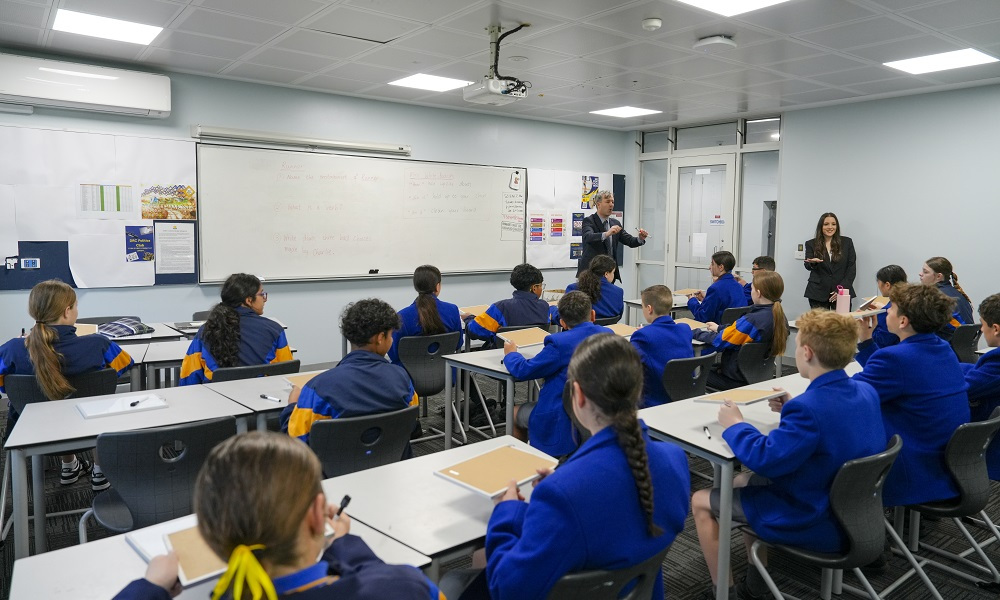Earlier this year, we published an article exploring what explicit instruction is, and since its publication, it’s been one of our most read articles of the year. So, how are leaders approaching supporting staff to utilise explicit instruction in their own settings?
In this leadership Q&A we speak to Kirsten Hodgson (Deputy Principal) and Bryan Kilkenny (Pedagogy Leader) from St Monica’s College (SMC) – a year 7-12 school in Melbourne. They discuss their approach to explicit instruction, how it fits into the Melbourne Archdiocese Catholic Schools (MACS) ‘Vision for Instruction’ model, and what they’ve learned from visiting other schools that have undertaken a similar journey.
To start things off, can you tell us a little bit about St Monica’s College and your roles there?
Kirsten Hodgson: St Monica’s College is a co-educational secondary college that serves the families of the northern suburbs of Melbourne. We are a 4-campus school. We currently have just under 2,200 students enrolled and have a staff base of over 380, which includes 241 teachers, making us one of the largest Catholic secondary schools in Victoria.
I am currently the Deputy Principal (Professional Practice), a role that has a considerable focus on the provision of opportunities to develop and nurture the professional growth of all our Monican colleagues. Professional learning, for both teaching and non-teaching staff, constitutes a large part of my role, as does the work I undertake with middle-level leaders to develop their capacity through leadership coaching.
Bryan Kilkenny: The role of Pedagogy Leader is a new addition to the school and one that I see as being the bridge between curriculum and assessment. In recent years, with the shift towards evidence-based practices, the school has made a commitment to staff development through the creation of the Professional Practice Team.
Our work is underpinned by the College’s Pedagogical Framework which utilises the metaphor of 3 interlinked gears of: Learning Environment, Instructional Model and Professional Enrichment all working together for the betterment of our staff and for the improvement of student learning outcomes.
At the start of 2024, Melbourne Archdiocese Catholic Schools (MACS) launched a new Vision for Instruction – a system-wide approach to teaching and learning that stresses the importance of evidence-based explicit instruction. What was SMC doing beforehand and what has Vision for Instruction looked like for your school in 2024?
KH: At SMC, the journey [of implementing explicit instruction] started quite a few years ago. At the time, Bryan was Faculty Leader of Learning Intervention, and he came to us to express an interest in researching evidence-based practices that would have the scope to improve the learning environment for our students and to shape more effective and consistent teaching practices. Bryan moved into the role of Pedagogy Leader in early 2023 and based on the recommendations he made to us, we worked to create the SMC Pedagogical Framework.
When MACS announced the launch of their Vision for Instruction at the start of 2024, we felt some trepidation as we were already on the journey to a new era of teaching and learning at SMC. We were, however, relieved to see that the Vision for Instruction aligned so well with our Pedagogical Framework. We found it quite seamless at that stage to introduce our staff at SMC to the [Vision for Instruction] position statement as they were able to see that natural alignment.
BK: Vision for Instruction came more as a timely affirmation rather than an antecedent for action.
What about the preparation for staff in reflecting on and shifting their own teaching practice? What has that professional learning support consisted of?
KH: We knew the importance of spending time with staff to explore the science of learning before asking our educators to consider how they could reflect on a more explicit model of instruction. The focus of our Teaching and Learning PL Day in August 2023 was to introduce staff to our Pedagogical Framework by devoting the day to first answering ‘why a framework?’ And then ‘why this framework?’
[These learning days] were successful in introducing our educators to both the science of learning and an introduction to retrieval practice.
We also have a Professional Learning Teams structure that has enabled our Curriculum Leaders to be trained up by our Pedagogy Leader, [so they are] able to lead small groups of staff with a specific focus from our Pedagogical Framework. This year, the focus is high quality questioning techniques. Each year we will introduce a different concept.
All our teachers are allocated an Annual Development Leader (a Curriculum Leader) who is assigned to coach and mentor them in and outside of the classroom and to work to embed strategies driven by our pedagogical approach. We are taking a steady approach to professional learning as we want to ensure that we embed best practice, and we know that takes time, rehearsal and revision.
Explicit instruction is often seen as teachers just ‘reading from a script.’ Can you provide some insight into how explicit instruction is used in practice at SMC
BK: In our first keynote on explicit instruction, staff were introduced to the different understandings of this model of teaching. For example … Barak Rosenshine and his Principles of Instruction (2012).
I modelled the idea of novices and experts in domain specific knowledge through the fun activity of drawing pandas to demonstrate that to learn a specific skill we need to break information into manageable chunks, practise after each step and receive feedback. Following this, staff were shown a series of examples [to further demonstrate this teaching approach], from speaking French to writing with appositive phrases. In each area, through a model of explicit instruction, staff were able to successfully achieve their goals. Staff were made aware of the novice to expert continuum and the appropriate use of methods of minimally guided instruction only once students have achieved a level of mastery.
Teachers have found it invigorating to know that they are the experts in the room. This means teachers are encouraged to fully explain all new concepts to students by breaking them down, retrieving knowledge to consolidate in long-term memory, provide opportunities for guided practice, and support those that need further explanation as all students move, in a highly guided manner, along the continuum towards expertise and mastery.
Additionally, to move knowledge from working memory to long-term memory and then build those schemas, or networks of knowledge, we have implemented retrieval practices and daily reviews to consolidate knowledge, which we know underpins all skill development. Again, we are working to codify these pedagogical practices with the implementation of a routine around ‘Do Nows’, which support both the learning environment and provide opportunities for spaced and interleaved practice.
What are some of the positive outcomes you hope to see from this shift in instructional practice?
BK: The improvements [are] profound when students are in a calm and orderly learning environment, supported by explicit and highly supported lesson content [that is] broken down into chunks, including reviews, guided practice, checks for understanding all in a gradual release of responsibility model.
As we continue to support staff through professional development and a highly supportive peer development program, we are confident that we will see further buy-in and implementation in classrooms.
We know we are at the beginning of a long journey but the positive impact on students will drive us to be better everyday day.
I understand you’re now visiting other schools to explore their teaching approach. How does this collaboration help you and your staff?
KH &BK: [We recently visited] schools in the Canberra-Goulburn Archdiocese (CECG). This region first commenced implementing the Catalyst Program (an explicit instruction framework) in 2021 so it was such a valuable experience to see what learnings the schools had 4 years into their journey. What gave us such confidence in what we have started [at SMC] is seeing the consistent quality of instruction that we observed in classrooms at St Mary Mackillop College and Merici College in Canberra. Both schools are seeing the fruits of their labour with NAPLAN results on the rise.
We were so impressed with the structure of lessons that we saw and the feeling of calm that swept through the corridors of both schools. We were blessed to spend so much time with the leadership teams who were incredibly generous in sharing their experience and learnings in implementing a system-wide approach to teaching and learning.
The key to the success that these schools have had is in their provision of high-quality and consistent professional learning for staff. It is critical that teachers have access to engaging PL that leads them to want to experiment and enrich their practice.
Our biggest takeaways from our visits to these exceptional schools in Canberra is the importance of a low-variance curriculum, which is going to provide us with great focus moving forward and, secondly, the need to teach for learning rather than teaching for performance.
References and related reading
Melbourne Archdiocese Catholic Schools Ltd, (2024). Vision for Instruction: Flourishng Learners Position Statement. https://www.macs.vic.edu.au/MelbourneArchdioceseCatholicSchools/media/Documentation/Documents/Vision-For-Instruction-Position-Statement.pdf
Rosenshire, B. (2012). Principles of Instruction: Research-Based Strategies That All Teachers Should Know. American Educator 36(1), 12-19, 39. https://www.aft.org/sites/default/files/Rosenshine.pdf
Does your school have a pedagogical framework that ensures all staff’s teaching practice is consistent and evidence-based?
‘The key to the success that these schools have had is in their provision of high-quality and consistent professional learning for staff.’ As a school leader, do you provide enough professional learning and development so that your staff have the knowledge and tools to implement best teaching practice?



